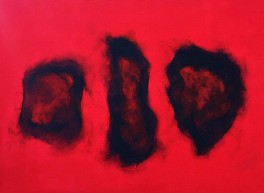BIOGRAPHY

American, 1918-2004
Cleve Gray (1918-2004) was admired for his large-scale, vividly colorful and lyrically gestural abstract compositions and achieved his greatest critical recognition in the late 1960's and 70's after working for many years in a comparatively conservative late-Cubist style. Inspired in the 1960's by artists like Jackson Pollock, Clyfford Still, Mark Rothko and Helen Frankenthaler, Gray began to produce large paintings using a variety of application methods - pouring, staining, sponging and other nontraditional techniques - to create compositions combining expanses of pure color and spontaneous calligraphic gestures.
Following graduation from Phillips Andover Academy Gray was initially bent on studying art in Europe but chose instead to attend Princeton University at the request of his father. At Princeton, the young artist studied history of art and philosophy and was first exposed to the abstract expressionist movement as well as to both Chinese and Japanese art. All these disciplines would have a profound effect on the young artist and his later work. Gray graduated Phi Beta Kappa and summa cum laude from Princeton in 1940; his thesis on Yuan Dynasty landscape painting is used as a teaching tool even to this day.
He fought in WWII. After the liberation of Paris, he was the first American GI to greet Gertrude Stein and Pablo Picasso. He continued to study art in Paris after the war, and trained with French artists Jacques Villon and Andre Lhote.
After returning to the United States in 1946, Gray began to exhibit his work at the Galerie Durand-Ruel in Paris. He had his first solo show at the Jacques Seligmann Gallery in New York in 1947. Gray moved into his parents’ old house in Warren, Connecticut in 1949, and lived there until his death in 2004. He married the author Francine du Plessix in 1957. They each had studios on the property, separated by a driveway.
Gray's early work was overly determined by Cubism. In the 1960s he formed a close friendship with Barnett Newman. It was during this time that he experienced an artistic metamorphosis, dissolving his earlier cubist compositions in a sea of distilled color. This dramatic body of work marked the beginning of an artistic meditation that would last for over 40 years. The rigors of French modernism, the ethos of Abstract Expressionism and the meditative restraint of Chinese and Japanese scroll painting (Betty Parsons called him "A painter who jumped the romantic fence into an ancient field of signs and symbols") commingle with astounding affect in the works of this period.
The artist is also represented in a number of important public collections including the Albright-Knox Art Gallery, The Brooklyn Museum, The Corcoran Gallery of Art, the Solomon R. Guggenheim Museum, The Smithsonian, The Jewish Museum, The Metropolitan Museum of Art, The Museum of Fine Arts, Boston, The Museum of Modern Art, The Newark Museum, The Phillips Collection, the Whitney Museum of American Art, the Yale University Art Gallery and most famously the Threnody murals at the Neuberger Museum
